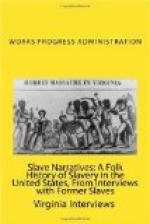“The biggest part of these niggers puts their mistakes on the white folks. It’s easier to do right than wrong cause right whips wrong every time into a frazzle.
“I don’t read much now since my eyes ain’t so good but tell me whatever become of Teddy Roosevelt?
“I’m sorry I can’t offer you no dinner but I’m just cookin’ myself some peas.
“Well, lady, I sure am glad you come. I jest knew the Lord was goin’ send somebody for me to talk to. I loves to talk so well. Good bye and come back again sometime.”
Interviewer: Mrs. Bernice Bowden
Person interviewed: Mary Williams
409
Hickory, Pine Bluff, Arkansas
Age: 84
[TR: Apparently a second interview with same
person despite age
discrepancy.]
“Yes ma’am, I know all about slavery. I’ll be eighty-four the twenty-fifth of this month. I was born in 1855.
“My mother had eleven children and they all said I could remember the best of all. I’m the second oldest. And they all dead but me.
“I used to spin and on Friday I’d set aside my wheel and on Saturday morning we’d sweep yards. And Saturday evening was our holiday.
“I belonged to the Lees and my white folks was good to me. I was the aptest one among ’em, so they’d give me a basket and a ginger cake and I’d go to the Presly’s after squabs. They’d be just nine days old ’cause they said if they was any older they’d be tough.
“Now, when the Yankees come through ever’body was up in the house ’cept me. I was out in the yard with the Yankees. No, I wasn’t scared of ’em—I had better sense.
“This is all the ’joyment I have now is to think back in slavery times.
“In slavery times white folks used to carry me to church. They’d carry me to church in preference to anybody else. When they’d sing I’d be so happy I’d hop and skip. I’m one of the stewardess sisters of St. John’s Methodist Church. We takes care of the sacrament table.
“I believe in visions. I’m a great revisionist. I don’t have to be asleep either. Now if I see a vision of a black snake, it’s a sign I got a black enemy. And if it’s a light colored snake, it’s a sign I got a white enemy. And if it’s a kinda of a yellow snake, I got a enemy is a yellow nigger.
“Now, here’s a true sign of death. If you dream of seen’ nakedness, somebody sure goin’ to die in your family or maybe your neighbors’.
“In slavery times they mostly wove their own dresses. Wove goods called muslin.
“And they wore bonnets in slavery times made out of bull rush grass. Called ’em bull rush bonnets. I knowed how to weave but they had me spinnin’ all the time.
“I’ve always worked for the ’ristocrat white people—lawyers, doctors, and bankers. Mr. Frank Head was cashier of that old Merchant and Planters Bank. He was a northern man. Oh, from away up North.
“When I cooked, the greatest trouble I had was gettin’ away. Nobody wanted me to leave. And I tell you those northern ladies wanted to call me Mrs. Williams. I’d say, ’Don’t do that. You know these southern people don’t like that—don’t believe in that.’ But you know she would call me Miss Mary. But I said, ‘Don’t do that.’




